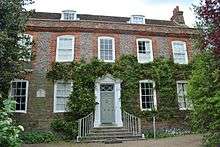Edith Shackleton Heald

Edith Shackleton Heald (12 September 1885 – 4 November 1976) was a bisexual British journalist who was the last mistress of the poet W. B. Yeats from 1937 until his death in 1939, and lived with the openly lesbian artist Gluck from 1944 until her death in 1976.
Yeats called her "the best paid woman journalist of her time", and Arnold Bennett called her the "most brilliant reviewer" in London.[1]
Early life
Edith Shackleton Heald was born on 12 September 1885[2] in Manchester, the younger daughter of John Thomas Heald, and Mary Shackleton. They were both from Stacksteads, Lancashire, and he was originally a schoolmaster. She had an older sister, Nora Shackleton Heald, with whom she co-owned the Chantry House. Nora would go on to be the editor of The Queen and The Lady. Her brother Ivan Shackleton Heald (1883–1916) was "Fleet Street's most acclaimed humorous writer" until he joined the Royal Flying Corps and died in the First World War.[1]
Career
Shackleton Heald was a "pioneering reporter",[3] and a special correspondent for the London Evening Standard and wrote for the Daily Express, the Sunday Express and the Daily Sketch.[4] Heald was not the only lesbian writing for the Evening Standard in the 1930s, as Evelyn Irons moved there from the Daily Mail, while recovering from a "tempestuous affair" with Vita Sackville-West.[5]
Personal life
W. B. Yeats was introduced to Heald in April 1937, by Edmund Dulac and Helen Beauclerc. Heald became his last mistress.[1] Yeats spent a good deal of time at her home, the Chantry House in Steyning, Sussex, where she lived with her sister Nora Shackleton Heald.[6][4]
Roy Foster, Yeats' official biographer, wrote, "While no longer capable of full intercourse, his relationship with Edith was intensely sexual: surviving blurry snapshots show her sunbathing bare-breasted in the Steyning garden under his rapturous gaze."[7] W. J. McCormack in his biography of Yeats states that they had sexual relations, but that Heald was a lesbian.[2]
When Yeats died on 28 January 1939, his wife George and Heald were both at his bedside at the Hôtel Idéal Séjour in Roquebrune-Cap-Martin.[8] Heald was present for his burial at Roquebrune cemetery.[2]
In 1944, Gluck moved into The Chantry House in Steyning to live with Heald, even though Gluck was still in love with her previous lover, Nesta Obermer (born Ella Ernestine Sawyer), who she viewed as her "wife", even though she was married to the much older American Seymour Obermer, who was able to fund her extravagant lifestyle.[4][5] Nesta enjoyed her life of international travel, arts patronage and parties, and was unwilling to divorce her wealthy husband, even if it had been possible in the 1930s. Gluck was still deeply in love with Nesta, Heald resented Nesta's hold on Gluck's affections, and Nora was jealous of Heald's love for Gluck.[5]
Death
Edith Shackleton Heald died on 4 November 1976, and Gluck on 10 January 1978.[4]
References
- 1 2 3 Joseph M. Hassett (22 July 2010). W.B. Yeats and the Muses. Oxford: Oxford University Press. pp. 215–216. ISBN 978-0-19-161489-7.
- 1 2 3 W J McCormack (11 January 2011). Blood Kindred: W. B. Yeats, the Life, the Death, the Politics. Random House. p. 50. ISBN 978-1-4464-4424-5.
- ↑ "GluckSteyne, Cricket Pavilion, Steyning Village, June 2 and June 9 (From The Argus)". Theargus.co.uk. Retrieved 2016-12-10.
- 1 2 3 4 Janet Cameron (21 October 2013). LGBT Brighton & Hove. Amberley Publishing Limited. pp. 56–58. ISBN 978-1-4456-2923-0.
- 1 2 3 Emily Hamer (6 October 2016). Britannia's Glory: A History of Twentieth Century Lesbians. Bloomsbury Academic. pp. 120–122. ISBN 978-1-4742-9279-5.
- ↑ Maddox, Brenda (14 May 2004). "Between the sheets" – via The Guardian.
- ↑ Brenda Maddox. "Biographer Brenda Maddox on the passion principle | Books". The Guardian. Retrieved 2016-12-10.
- ↑ Lara Marlowe (2014-01-28). "The end of Yeats: work and women in his last days in France". Irish Times. Irishtimes.com. Retrieved 2016-12-10.